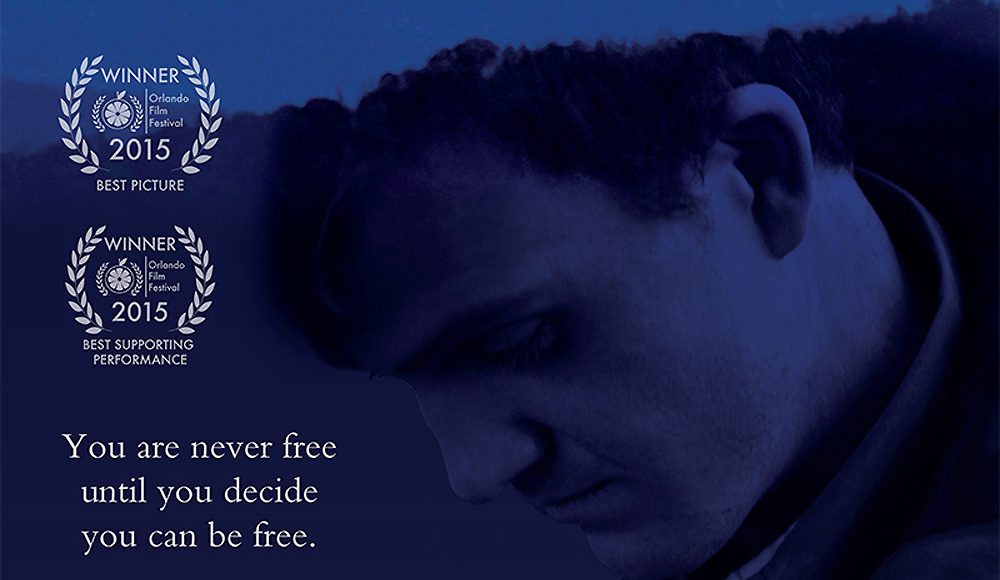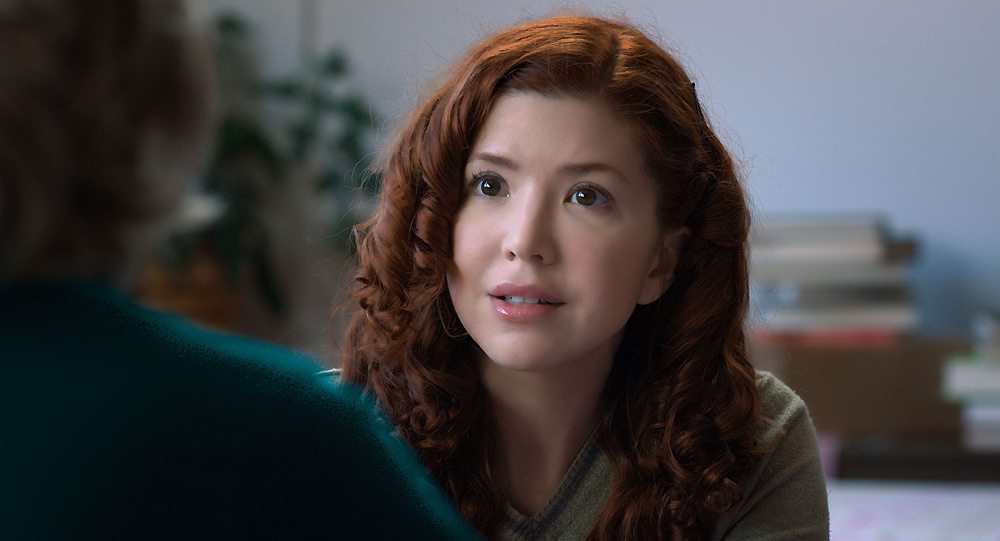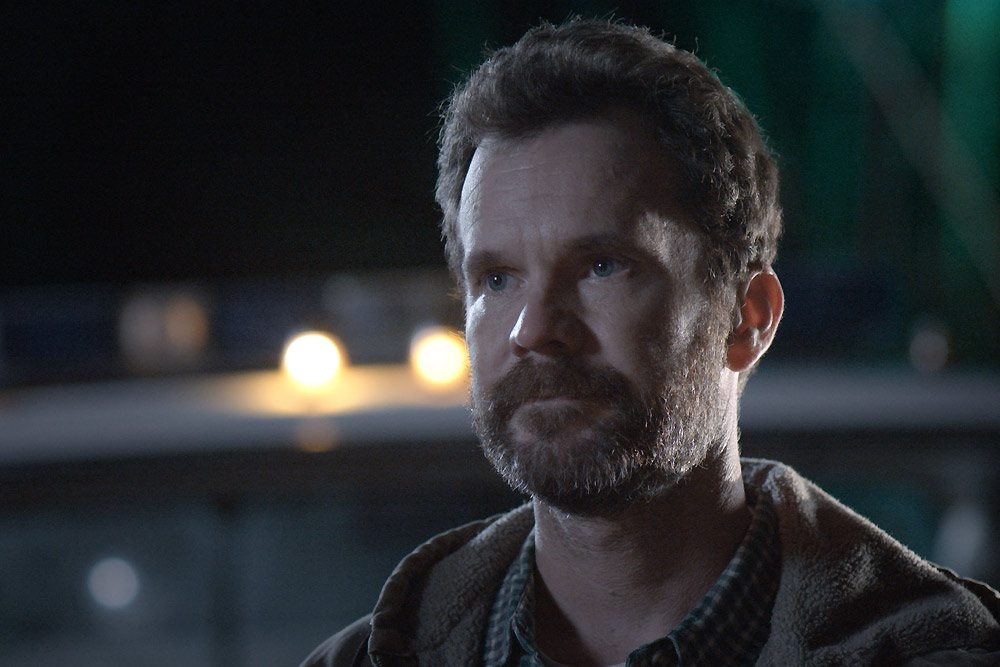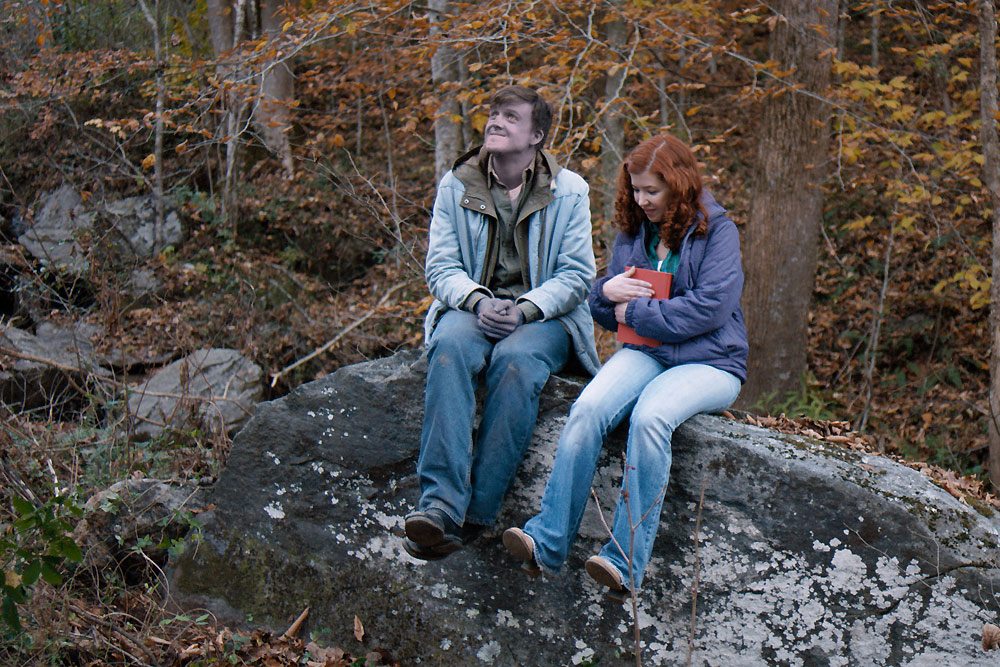By Darwyn Carson — Blue, by filmmaker Charles Huddleston, is not a complex plot. It’s a pretty straightforward morality tale wrapped in the landscape and backwoods mores of Appalachian country and the “Mountain People” who reside “in them thar hills.”
Within seconds of being fed an endorphin lifting, panoramic view of a luscious blue-green mountain range, we witness what looks to be a young man—face obscured by his hooded jacket—descend from the undergrowth of a mountainous terrain. His path appears meandering, with no intended destination in mind. He ambles along, stopping to take in the sky, sitting on a boulder, gazing at the majestic scenery. He doesn’t appear to be distressed. He appears to be… aimless.
We see a young auburn-haired girl, Pearl Murphy (Michele Martin), playing with her two kid sisters somewhere along a river’s edge. Heading home, they are spied by the young man—we’re able to see him more clearly now—who chooses to surreptitiously follow them. He even creeps up to a window to sneak a peek once they are home and inside.
At this point we can see him clearly, however it takes a moment for our minds to believe what our eyes have registered. The young man is blue. His skin tone: Blue.
What we come to realize, through vague references, is that he comes from a people who live far up the Appalachia range. Mountain folk rarely, if ever seen, but who are rumored about by the townsfolk lower down.
Blue (as the young man says he is called) suffers from a skin condition which, as his name indicates, has bestowed his skin with a blue-like tinge.
For reasons which go unstated during the story’s unfolding, Blue has left the only surroundings he’s ever known to go on—it would seem—a walk-about. He enters the town proper, but not understanding everyday things like traffic signals for instance, he walks down the middle of the street; until the town sheriff (Sean Bridgers – Deadwood, Rectify) forces him to the sidewalk. His mannerisms suggest he is disadvantaged to some degree, but we are left to surmise what that is as it’s never made clear.
Not everyone takes to Blue. Some treat him rudely, most people stare and others, like the sheriff’s brother and his friends are over-the-top brutish in their behavior. Two townsfolk, nicely portrayed by Kelly McGillis and Dale Dye initially go out of their way to avoid him, though later let down their guard enough to gift Blue with a degree of acceptance.
Blue and Pearlie’s paths eventually do, directly, intersect and over a period of time a bond is formed; which is where the true heart and strength of the tale lay. It is their connection and personal themes that drive the bubble of toil and trouble. As such, and unfortunately, it is also where the weakness of the film resides.
Michele Martin as Pearlie is pretty solid, with a quiet, natural appeal. She, not only, comes off as genuine, the adage, “the camera loves her” also applies.
I’m not certain if the issue with the role of Blue, portrayed by newcomer Drew Connick, is in the performance or the character with which he was presented. Perhaps it is a blend.
Co-scripted by Martin and director/coproducer Charles Huddleston, the seed for Blue’s core story sprung from an event which Huddleston, who’s family hails from the rural regions of Southwestern Virginia, remembers well:
“…at an early age, my grandmother told me the story of the blue people who lived in nearby Kentucky. Their story has become, fairly, well-known, in the 1960s a group of people walked out of the mountains and into a small-town doctor’s office, their skin as blue as someone suffocating. It turned out these people had a rare genetic disorder, also documented as occurring previously in Ireland, that causes their blood to oxygenate differently than most people’s, their red blood cells being blue.”
Huddleston goes on to detail the idiosyncrasies of this condition: Methemoglobinemia and also the fact that there is a treatment. An injection of methylene blue can produce immediate results whereby the individual’s skin tone turns a natural flesh tone. Under some medical conditions, the treatment doesn’t work. The problem is, these significant issues are not clearly illuminated in his film.
What does work for ‘Blue’ is the basic theme of exclusion or inclusion.
Most individuals can relate to having been the “odd man out,” even if only in temporary situations. That the titular character has an inherent feature outside of his control, makes this more meaningful. This is not a haircut that will grow out, a mode of dress that can be altered, a pimple cream that can be applied or even immature behavior that one can change.
Added to our main guy’s skin condition are his opening interactions with townspeople, which are halted and odd. (Although when he does utter his first words, it’s almost a surprise. Although he speaks in fits and starts, he sounds almost refined; Pearlie’s dialect being more “backwoods” than his.)
His strange habit of sneaking around behind Pearlie, his hesitant speech pattern, his awkward physicality raises questions needing to be answered, but aren’t.
The viewer is left to fill in the holes with only a tidbit of information.
He doesn’t know what traffic signals are, never been in a car before. He views everything with a bit of awe and rapture about him. Are we to assume he’s never been to an accredited school, never been around other people before…? Is this is his first time even coming to a township? Why did he pick now to come down out of the mountains? Is he autistic, or an idiot savant? Is he intelligent, but uneducated? He can read because he sees a “Help Wanted” placard and gets a job in the general mercantile store working with customers and assisting the owner. How is it he assimilates so swiftly to his new environs?
Pearlie’s is a well laid-out, troubling story; as a result, we get what it is that drives her. She loves her family; is a mama bear for her two baby sisters and is desperate to find Billy, her missing brother. She strives to keep the family’s dark secrets behind closed doors while she maintains a light spirit in the face of an alcoholic, changeable father.
What we crave is information about Blue because nothing about him is provided. We never even learn, within the structure of the film, the specifics or peculiarities about his skin condition, which would have explained a lot. Example: Blue’s skin appears a rich, dark blue, one traumatic evening when he’s inside Pearlie’s house. It turns out to have been a side effect of this disorder, but without that information provided to us, it appears to be a misstep on the filmmaker’s part.)
If presented properly a “mysterious” persona of a character who exists within the structure of a film can be perceived as a plus. Here, it didn’t work as such.
I don’t have problems with simple stories well-told. I do have issues with simple stories hastily handled.
I could go on, but won’t. While I didn’t hate Blue, I wanted to like it a whole lot more. It promotes our sameness as human beings, with all of us being part of the family of man; while our differences, no matter what they might look like, merely individualize one another within the family structure.
Ultimately, we are all perfect just as we are. A pretty cool message.
♦ ♦ ♦
Support the Voices of The TVolution
Like us on Facebook and Please Subscribe








